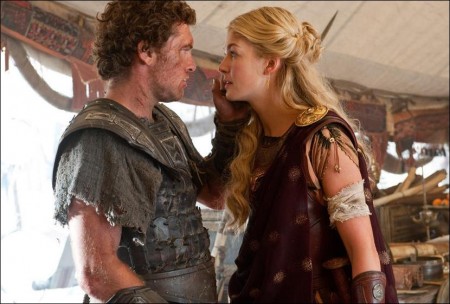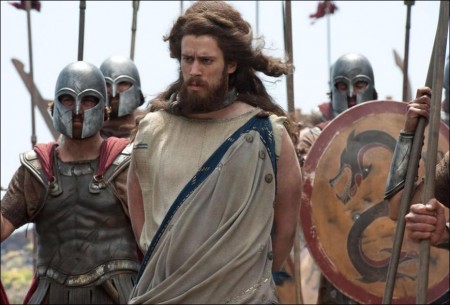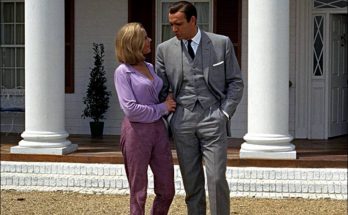Wrath of the Titans: Return to an ancient land. To recreate ancient Greece, the production team on “Wrath of the Titans” once again returned to the unique and exquisite landscape of the Canary Islands’ Tenerife, as well as locations in and around England’s Shepperton Studios, and the dark quarries of Wales.
“The Canary Islands gave us great contrasts, including the beautiful, blue sea, dusty landscapes and townscapes, wide open areas to stage a massive battle in the middle of a volcano… We just couldn’t have asked for more out of one locale,” Liebesman says.
Production designer Charles Wood found that the area blended well with his director’s vision. “Jonathan is a very graphic director, which was great for me because he was really able to give a sense of what he was envisioning. We discussed color reference, textural reference, and put together a broad palette to work from. He appreciates strong, clear-cut imagery, which is precisely what Tenerife offers,” he relates.
The coastal resort of Abades was chosen for the film’s biggest set build: the bustling fishing village that is home to Perseus and his son, Helius, and the site of the Chimera’s violent attack.
“We chose that particular spot because it has a lot of topography to it, with a clean vista looking out onto the ocean; it wasn’t just flat space,” Wood elaborates. “We took references from villages in Afghanistan, North Africa and the Middle East, where a lot of ancient cultures still exist.”
From Wood’s designs, the special effects team, headed by Neil Corbould, sculpted a selection of biscuit foam rocks for the buildings, many of which would be detonated using high pressure compressed air or pyrotechnic charges. Liebesman was thrilled with the transformation Wood and his team brought about. “Perseus lives on the outskirts of Greek life in a poor village. It’s hardscrabble. The attention to detail that Charlie brought to every corner of every hut was inspiring, and I wanted to shoot every inch of what he created before we had to blow it up.”
A short drive from Abades, Los Desriscaderos served as the location for the exterior of the intricate labyrinth leading to Tartarus. In addition, several scenes were accomplished within the volcanic national park of Mount Teide: Queen Andromeda’s initial military encampment was built at Minas de San Jose; and Llano de Ucanca stood in for the spectacular exterior of the Mount of Idols.
Teno Rural Park, a volcanic mountain where erosion has shaped the current landscape of large, coastal cliffs, did double duty in the film: in the opening scene as the location of Io’s seaside grave, and as the location where Perseus, Agenor, Andromeda and her soldiers board the majestic ship, the Nomos.
“The Nomos was featured in the first film,” Wood says, “but it underwent some major cosmetic changes for ‘Wrath.’ We needed it to be longer, so we cut it in half, added about 20 feet in its beam, and then rebuilt it. We laid a new deck, redesigned the bow and stern and built two masts. The ship was constructed in Cornwall and then traveled to Tenerife by land and sea.”
For a scene involving the ship at sea, the cast and crew boarded several boats, dropping anchor in front of the Los Gigantes cliffs, which offered a magnificent backdrop. “Los Gigantes has tremendous scale and mystery, having been formed by massive lava flows,” Wood says. “I have never seen anything more breathtaking.”
Before departing Tenerife, the visual effects team and a splinter second unit peeled off from the main unit to film several “journeying” shots over the Canaries’ Roque de Agando in nearby La Gomera, a magnificent volcanic dome formed five million years ago and one of the area’s most striking features. The additional footage was used not only for plates, but also for recreating CG backgrounds that would extend beyond the battlefield sequences the filmmakers would capture in Wales.
The remainder of the movie was filmed in the UK. In Surrey, England, the Redlands Wood became the Isle of Kail, the woodland home of Hephaestus and his fierce guards, the Cyclops. The production’s home base was located at Shepperton Studios, where the art department, costume department, visual effects workshops and editing were also situated. They utilized several soundstages there for set builds, including the labyrinth, the Minotaur’s lair, Hephaestus’ forge, the interiors of the Temple of Idols and Perseus’ hut, Agenor’s jail cell and the ultimate prison, Tartarus.
Perhaps no set called for a greater combination of design and function than the labyrinth. “The labyrinth was good fun,” Wood recalls. “It was tricky, though, because of all the moving parts and the fact that it needed to feel like a never-ending space. The special effects team did a tremendous job working out the mechanics of the set, helping us to create moments in the film when the characters walk over bridges and we see swirling cylinders, interconnecting corridors, and massive stone blocks moving all around them.”
“If there’s a horror movie element in this film, that is the labyrinth,” Iwanyk suggests. “It is the home of the Minotaur, and it preys upon your worst fears.”
Another fear-inducing site in the film is Tartarus, where Kronos is slowly breaking free as he absorbs the remaining power from Zeus, who stands chained and helpless thanks to the unholy alliance formed by Hades and Ares. Inspired by the artist John Martin’s paintings, which the director calls “turbulent and surreal,” Liebesman had a very specific idea of how it should appear.
“To me, the Underworld has always been a dark representation of the inside of the earth. It’s not really a cave; it’s immense, with rounded surfaces above that are the underside of the oceans and mountains-almost a world within a world, with Tartarus at its very core. Looking at it that way, I think it gave us a lot of room to play with the design.”
“We built a little piece of it,” Wood says, “and the effects department came in to really capture the rest of the huge chasm of the earth that became our Underworld.”
VFX supervisor Nick Davis enjoyed creating what he describes as “the bizarre, twisted, cathedral-like, 4,000-foot structure that is essentially a prison of stone from which Kronos, during the course of the film, breaks through and comes to life.” The production travelled to South Wales for the final two weeks of filming in order to shoot the explosive battle scene in which man takes on the ferocious powers of the Underworld. Andromeda’s military camp at Argos was built at a slate quarry on the outskirts of Merthyr Tydfil, once the largest town in Wales. Coincidentally, the area has its own royal-and violent-history: it was named for Saint Tydfil, the daughter of King Brychan of Brycheiniog, who was slain in approximately 480 A.D.
“The final battle is massive,” Iwanyk states. “We had hundreds of soldiers and horses, trebuchets and arrows flying. It’s a fight to the finish between Kronos and his army of creatures, and the armies of mankind-the Spartans, the Athenians, the army of Argos-all there for the final stand. It’s like the battle of Thermopylae or Stalingrad or any pivotal conflict. If we don’t win here, life as we know it is over.”
Wrath of the Titans
Directed by: Jonathan Liebesman
Starring: Sam Worthington, Rosamund Pike, Liam Neeson, Ralph Fiennes, Édgar Ramírez, Bill Nighy, Danny Huston, Lily James, Kathryn Carpenter
Screenplay by: Dan Mazeau, David Johnson
Production Design by: Charles Wood
Cinematography by: Ben Davis
Film Editing by: Martin Walsh
Costume Design by: Jany Temime
Set Decoration by: Lee Sandales
Art Direction by: Thomas Brown, Ray Chan, Jordan Crockett, Stuart Kearns, Mike Stallion, Mark Swain
Music by: Javier Navarrete
MPAA Rating: PG-13 for intense sequences of fantasy violence and action.
Studio: Warner Bros. Pictures
Release Date: March 30, 2012
Related Link: View the Full Production Notes for Wrath of the Titans
Views: 95




